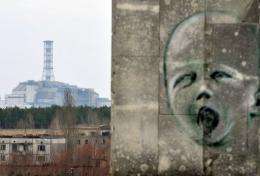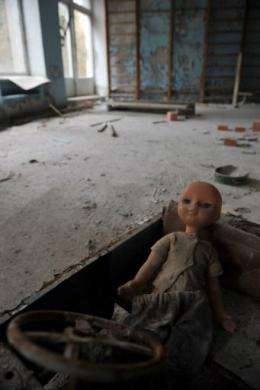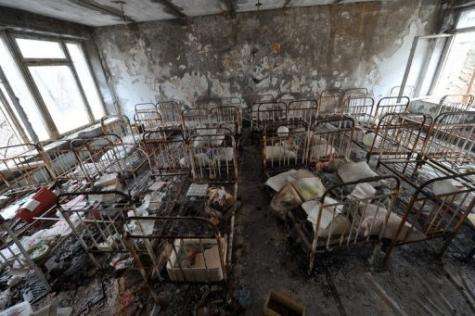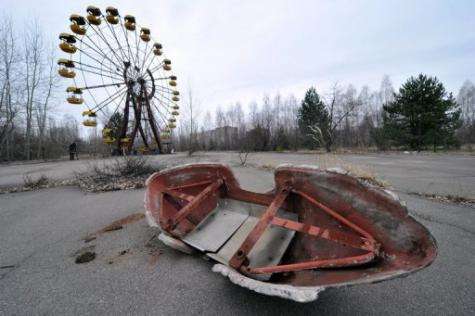Ghost city symbolises cost of nuclear disaster

"Careful -- do not touch anything with your bare hands!" warned the guide as we entered the kindergarten and our Geiger counter hissed like an angry rattlesnake.
On the floor and shelves were plastic cubes and teddy bears and kiddies' books, just the things you would expect to find in a children's playgroup.
But these toys were coated in a thick leprous white dust, for they had lain undisturbed for almost a quarter of a century.
And scattered among them were infant-sized gas masks.
Something terrifying had made the toddlers flee their innocent corner of the world. Their home, Pripyat, once a model city, had become the set for a true-life apocalypse movie.
Cursed by the winds that blow from Chernobyl a few kilometres (couple of miles) away, Pripyat is a snapshot of the astronomical cost of the world's worst nuclear disaster. And its fate stirs chilling thoughts for Japan, grappling with its own nuclear crisis in Fukushima.
Pripyat's entire population of nearly 50,000 fled after Chernobyl's No. 4 reactor exploded in a devil's brew of caesium, strontium, iodine and plutonium on April 26, 1986.
"Pripyat was considered to be one of the best places to live in the Soviet Union," said Nikolai Fomin, a young Ukrainian who escorts visitors into the 30-kilometre (18-kilometre) exclusion zone around Chernobyl.
"It was considered a very happy place. It had good housing and schools, lots of young families, and the shops were filled with things you couldn't get elsewhere."

Today, trees thrust through the tarmac of the long-untended roads. Grass grows between cracks in pavements, where dry leaves click metallically in the sour wind. Apartment windows stare down on the streets like dark, lidless eyes.
"Everything here was new, everything was modern," said Fomin. "Pripyat was only 16 when it died."
Occasional visitors come by bus for a lightning tour, equipped with radiation dosimeters, hand wipes and water with which to decontaminate boots and clothing when they leave. But other than that, there is not a soul.
"Animals come, but they are not afraid of humans," said Fomin.
The city's swimming pool echoes to the crunch of broken glass and tile underfoot. In a fairground, the yellow gondolas of a Ferris wheel -- due to have been inaugurated on May Day in 1986 but never used -- creak in the wind. Dodgem cars rust at the spot where they stopped after their last ride.
In the main square, a rusting Soviet hammer and sickle overlook the Hall of Culture. In a back room of what seems to be a community hall are stacked placards of Lenin and Soviet leaders that had been prepared for the May 1 parade but were never used.

Resettling the people of Pripyat and other villages in the exclusion zone, sealing the crippled reactor, cleaning up the power plant, monitoring regions contaminated by fallout... the bill for Ukraine has been almost incalculable.
Even today, around five percent of its annual budget is devoted to Chernobyl-related benefits, including payment of a small sum, known darkly as "funeral money", to help people in contaminated regions buy clean food.
Belarus and Russia have also been badly hit. Together the three countries had relocated more than 330,000 people.
Up till 2005, the direct and indirect costs were "hundreds of billions of dollars", according to a 2005 report by the Chernobyl Forum, gathering those three countries, seven UN agencies and the World Bank.
In terms of the human toll and radioactive pollution, Fukushima is so far not remotely comparable with Chernobyl, said Malcolm Grimston, a nuclear specialist at Britain's Chatham House think tank.
But the duration of the evacuation zone around Fukushima remains unknown and the cleanup of the plant will surely last decades, he said.

The financial bill for Japan could eventually be comparable to Chernobyl, given the greater expense, disruption to business and higher cleanup standards compared to the former Soviet Union, he said.
"As a rule of thumb, the more developed the country, the higher the cleanup costs will be," said Grimston.
"However, it will be hard to separate out responsibility and costs between the earthquake, the tsunami and specific responsibility by TEPCO," the Tokyo Electric Power Co. (TEPCO), which operates the Fukushima No. 1 plant, he said.
In Tokyo, shares in TEPCO, have lost more than four-fifths of their value since the March 11 earthquake. On Tuesday, the price fell to a record low amid analysts' concerns it would face claims of more than 10 trillion yen (118 billion dollars/83 billion euros).
(c) 2011 AFP

















